2022年中考英语二轮专题复习课件:专题十二 动词的语态(共有PPT27张)
文档属性
| 名称 | 2022年中考英语二轮专题复习课件:专题十二 动词的语态(共有PPT27张) | 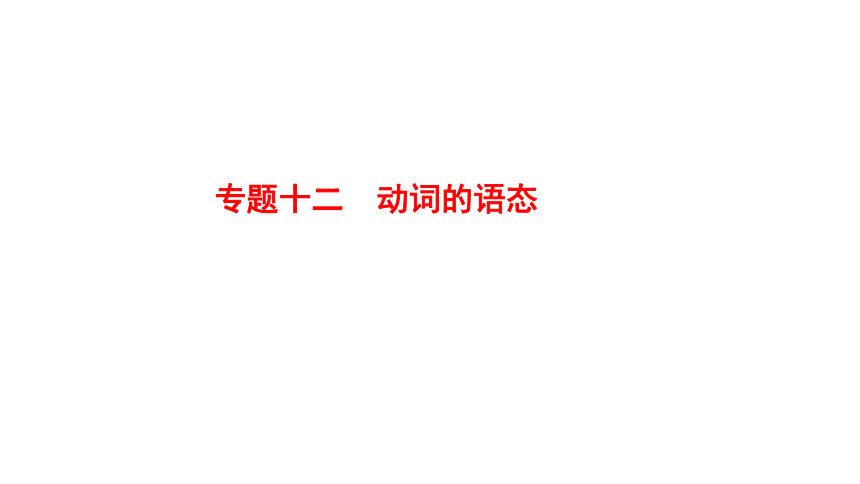 | |
| 格式 | zip | ||
| 文件大小 | 416.0KB | ||
| 资源类型 | 教案 | ||
| 版本资源 | 人教新目标(Go for it)版 | ||
| 科目 | 英语 | ||
| 更新时间 | 2022-01-05 08:36:10 | ||
图片预览


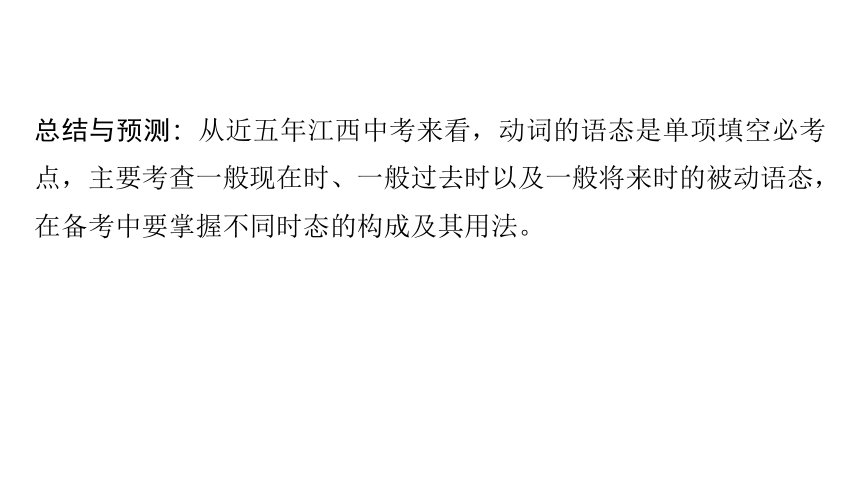
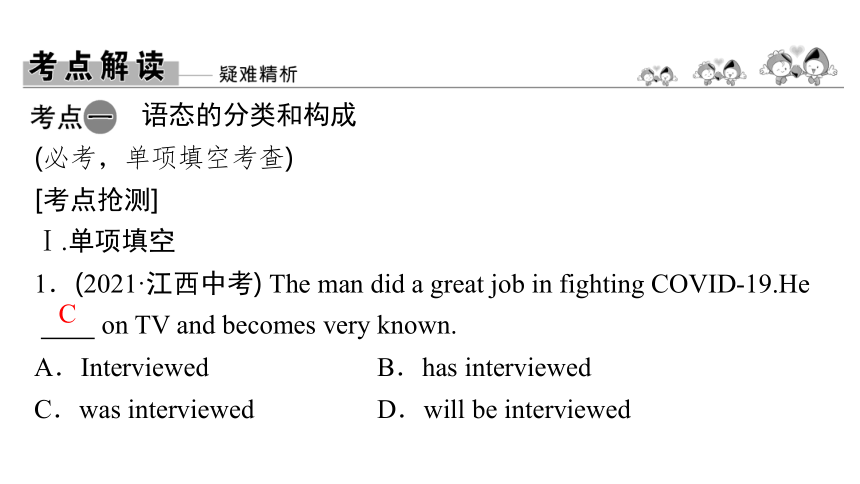

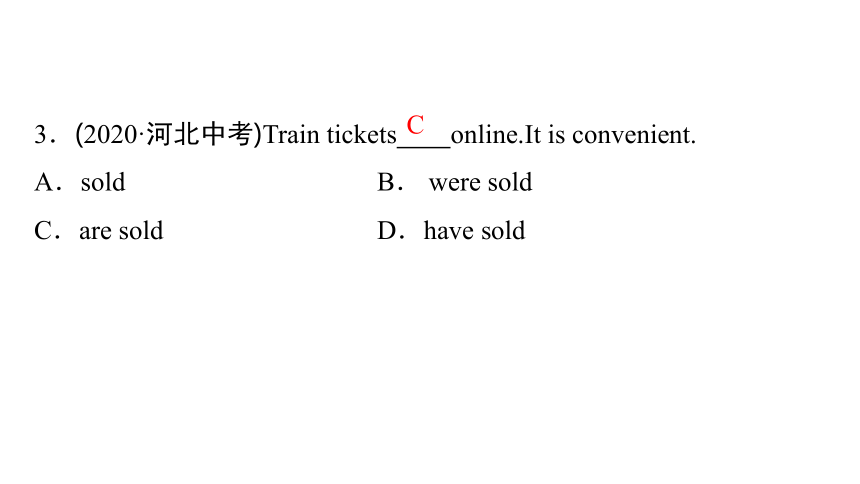


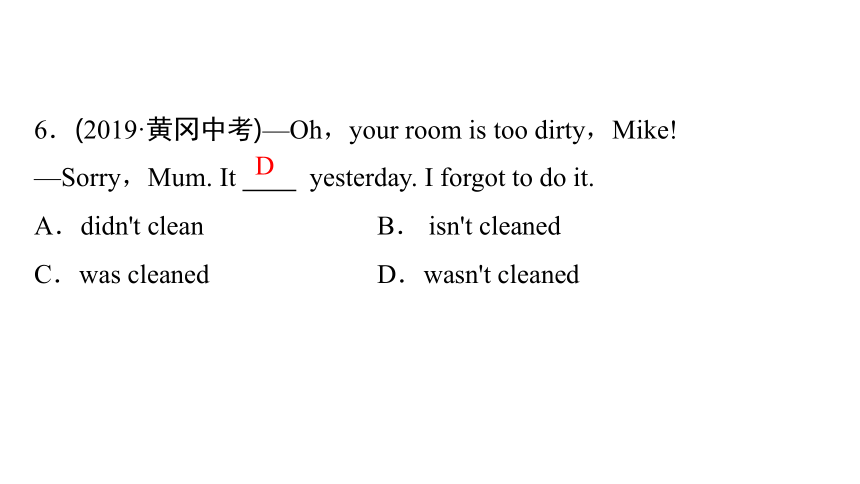
文档简介
(共27张PPT)
专题十二 动词的语态
总结与预测:从近五年江西中考来看,动词的语态是单项填空必考点,主要考查一般现在时、一般过去时以及一般将来时的被动语态,在备考中要掌握不同时态的构成及其用法。
语态的分类和构成
(必考,单项填空考查)
[考点抢测]
Ⅰ.单项填空
1.(2021·江西中考) The man did a great job in fighting COVID 19.He
on TV and becomes very known.
A.Interviewed B.has interviewed
C.was interviewed D.will be interviewed
C
2.(2020·北京市)The kite in China more than 2,000 years ago.
A.invents B. invented
C.is invented D.was invented
D
3.(2020·河北中考)Train tickets online.It is convenient.
A.sold B. were sold
C.are sold D.have sold
C
4.(2019·扬州中考改编)The 2021 International Horticultural Expo
in Yangzhou.
A.holds B. will hold
C.is held D.will be held
D
5.(2019·宜昌中考)—It's reported that 31 of the brave young men ____
in a big forest fire in Sichuan.
—I don't know who they are,but I know who they are for.
A.were killing B. were killed
C.killed D.had killed
B
6.(2019·黄冈中考)—Oh,your room is too dirty,Mike!
—Sorry,Mum. It yesterday. I forgot to do it.
A.didn't clean B. isn't cleaned
C.was cleaned D.wasn't cleaned
D
Ⅱ.把下列句子改成被动语态
1.We can finish the work in two days.
The work in two days.
2.They produce silk in Suzhou.
Silk in Suzhou.
can be finished
is produced
3.The children will sing an English song.
An English song by the children.
4.We should plant some trees in our school.
Some trees by us in our school.
5.Lucy sent me a New Year card last week.
A New Year card to me by Lucy last week.
will be sung
should be planted
was sent
[考点剖析]
一、动词语态的分类
英语中有两种语态:主动语态和被动语态。
1.主动语态表示主语是动作的执行者。如:
Many people speak English there.那里很多人说英语。
2.被动语态表示主语是动作的承受者,即行为动词的对象。如:
Chinese is spoken by many people.汉语被很多人说。(Chinese是动词speak的承受者)
二、被动语态的构成
被动语态由“be+及物动词的过去分词(用done表示)”构成。常见的4种时态的被动结构如下:
时态 被动结构 例句
一般现
在时 am/is/are+done This kind of car is made in China.这种车是中国制造的。
一般过
去时 was/were+done The flying disk was invented by college students.这种飞碟是大学生们发明的。
时态 被动结构 例句
一般将来时 will/shall+be+done The bridge will be finished in a month. 这座桥将在一个月后竣工。
情态动词 情态动词+be+done Tables can be made of stone.
桌子可由石头制造。
三、主动语态变被动语态的方法
1.图示
2.口诀:宾变主,主变宾,谓语动词用被动。
3.变换步骤:
(1)将主动句的宾语变为主语。
注意:如果主动句的宾语是代词,需将其由宾格变为主格。如:
Tom saved him.→He was saved by Tom.汤姆救了他。
(2)将动词改为“be+过去分词”。
注意:be动词与新主语相一致,时态不变。如:
They held a meeting yesterday.→A meeting was held by them yesterday.他们昨天开会了。
(3)将主动语态的主语改为by...放在谓语动词后。
注意:如果原主语是代词,则应由主格变为宾格。如:
He sang a song.→A song was sung by him.他唱了一首歌。
4.分析江西近5年考情发现,涉及语态的试题选项中通常有主动和被动,并且有现在时态和过去时态。学生在做题时,可从以下角度入手分析:
(1)判断句子是主动语态还是被动语态
读懂句意,确定主语,判断主语表示人还是物,主语是动作的执行者还是承受者。当主语为人时,需根据句意及谓语动词判断。
该动作是否是主语发出:若为主语发出,用主动语态;若不是主语发出,用被动语态。对于被动语态来说,试题主要是让大家找出谓语动作的执行者或承受者,这就要根据句子的意思进行判断。
(2)确定句子的时态
被动语态的使用离不开时态,所以应根据句中的时间状语、上下文的暗示或动作发生的时间来判断应使用哪种时态的被动语态。
四、常见主动语态变被动语态的特殊结构
1.含有双宾语(即直接宾语和间接宾语)的句子,多把间接宾语变为主语,直接宾语不变。如:
Jack told us the truth.→We were told the truth by Jack.杰克告诉了我们真相。
2.主动语态中有些感官动词(如:hear,see,watch,notice等)后用不带to的不定式作宾语补足语,变为被动语态时,要把不定式符号to还原。如:
hear(see)sb.do sth.→sb.be heard(seen)to do sth.
We heard the girl play the piano in the music classroom.→The girl was heard to play the piano in the music classroom.我们听见那个女孩在音乐教室弹钢琴。
3.主动语态中有些使役动词(如:make,let等)后用不带to的不定式作宾语补足语,变为被动语态时,同样要把不定式符号to还原。如:
make sb.do sth.→sb.be made to do sth.
The teacher makes his students do much homework every day.→His students are made to do much homework by the teacher every day.那位老师让他的学生每天做很多家庭作业。
主动语态表示被动意义
(五年未考,仅作了解)
[考点抢测]
Ⅰ.单项填空
1.Some people waste too much water. They don't believe that it can
some day.
A.keep out B. run out
C.be run out D.run out of
B
2.(原创题)In the past few years,great changes in Jiujiang.
A.take place B. took place
C.have taken place D.have been taken place
C
Ⅱ.用所给词的适当形式填空
1.This kind of watch (sell)well.
2.The Mapo Tofu (taste)good.
3.The book is so educational that it is worth (read)again.
sells
tastes
reading
[考点剖析]
英语中有很多动词, 如break,catch,clean,drive,lock,sell,write,wash等,被用作不及物动词来描述主语特征时,常用其主动形式表达被动意义,主语通常是物。
1.feel,look,sound,smell,taste等系动词的主动语态表示被动含义。 如:
The air in the forest smells very fresh after rain.雨后森林的空气闻起来很清新。
2.wash,clean,cook,cut,read,wear,draw,write,sell,drive等和well,easily搭配时,用主动形式。 如:
My coat washes easily.我的外套很容易清洗。
3.在need,require,want,worth等后跟动名词表示被动意义。 如:
His bike needs mending.他的自行车需要修一下。
4.用于特殊结构“make oneself heard/understood”和“have sth.done”结构中。如:
I had my hair cut yesterday.我昨天剪头发了。
专题十二 动词的语态
总结与预测:从近五年江西中考来看,动词的语态是单项填空必考点,主要考查一般现在时、一般过去时以及一般将来时的被动语态,在备考中要掌握不同时态的构成及其用法。
语态的分类和构成
(必考,单项填空考查)
[考点抢测]
Ⅰ.单项填空
1.(2021·江西中考) The man did a great job in fighting COVID 19.He
on TV and becomes very known.
A.Interviewed B.has interviewed
C.was interviewed D.will be interviewed
C
2.(2020·北京市)The kite in China more than 2,000 years ago.
A.invents B. invented
C.is invented D.was invented
D
3.(2020·河北中考)Train tickets online.It is convenient.
A.sold B. were sold
C.are sold D.have sold
C
4.(2019·扬州中考改编)The 2021 International Horticultural Expo
in Yangzhou.
A.holds B. will hold
C.is held D.will be held
D
5.(2019·宜昌中考)—It's reported that 31 of the brave young men ____
in a big forest fire in Sichuan.
—I don't know who they are,but I know who they are for.
A.were killing B. were killed
C.killed D.had killed
B
6.(2019·黄冈中考)—Oh,your room is too dirty,Mike!
—Sorry,Mum. It yesterday. I forgot to do it.
A.didn't clean B. isn't cleaned
C.was cleaned D.wasn't cleaned
D
Ⅱ.把下列句子改成被动语态
1.We can finish the work in two days.
The work in two days.
2.They produce silk in Suzhou.
Silk in Suzhou.
can be finished
is produced
3.The children will sing an English song.
An English song by the children.
4.We should plant some trees in our school.
Some trees by us in our school.
5.Lucy sent me a New Year card last week.
A New Year card to me by Lucy last week.
will be sung
should be planted
was sent
[考点剖析]
一、动词语态的分类
英语中有两种语态:主动语态和被动语态。
1.主动语态表示主语是动作的执行者。如:
Many people speak English there.那里很多人说英语。
2.被动语态表示主语是动作的承受者,即行为动词的对象。如:
Chinese is spoken by many people.汉语被很多人说。(Chinese是动词speak的承受者)
二、被动语态的构成
被动语态由“be+及物动词的过去分词(用done表示)”构成。常见的4种时态的被动结构如下:
时态 被动结构 例句
一般现
在时 am/is/are+done This kind of car is made in China.这种车是中国制造的。
一般过
去时 was/were+done The flying disk was invented by college students.这种飞碟是大学生们发明的。
时态 被动结构 例句
一般将来时 will/shall+be+done The bridge will be finished in a month. 这座桥将在一个月后竣工。
情态动词 情态动词+be+done Tables can be made of stone.
桌子可由石头制造。
三、主动语态变被动语态的方法
1.图示
2.口诀:宾变主,主变宾,谓语动词用被动。
3.变换步骤:
(1)将主动句的宾语变为主语。
注意:如果主动句的宾语是代词,需将其由宾格变为主格。如:
Tom saved him.→He was saved by Tom.汤姆救了他。
(2)将动词改为“be+过去分词”。
注意:be动词与新主语相一致,时态不变。如:
They held a meeting yesterday.→A meeting was held by them yesterday.他们昨天开会了。
(3)将主动语态的主语改为by...放在谓语动词后。
注意:如果原主语是代词,则应由主格变为宾格。如:
He sang a song.→A song was sung by him.他唱了一首歌。
4.分析江西近5年考情发现,涉及语态的试题选项中通常有主动和被动,并且有现在时态和过去时态。学生在做题时,可从以下角度入手分析:
(1)判断句子是主动语态还是被动语态
读懂句意,确定主语,判断主语表示人还是物,主语是动作的执行者还是承受者。当主语为人时,需根据句意及谓语动词判断。
该动作是否是主语发出:若为主语发出,用主动语态;若不是主语发出,用被动语态。对于被动语态来说,试题主要是让大家找出谓语动作的执行者或承受者,这就要根据句子的意思进行判断。
(2)确定句子的时态
被动语态的使用离不开时态,所以应根据句中的时间状语、上下文的暗示或动作发生的时间来判断应使用哪种时态的被动语态。
四、常见主动语态变被动语态的特殊结构
1.含有双宾语(即直接宾语和间接宾语)的句子,多把间接宾语变为主语,直接宾语不变。如:
Jack told us the truth.→We were told the truth by Jack.杰克告诉了我们真相。
2.主动语态中有些感官动词(如:hear,see,watch,notice等)后用不带to的不定式作宾语补足语,变为被动语态时,要把不定式符号to还原。如:
hear(see)sb.do sth.→sb.be heard(seen)to do sth.
We heard the girl play the piano in the music classroom.→The girl was heard to play the piano in the music classroom.我们听见那个女孩在音乐教室弹钢琴。
3.主动语态中有些使役动词(如:make,let等)后用不带to的不定式作宾语补足语,变为被动语态时,同样要把不定式符号to还原。如:
make sb.do sth.→sb.be made to do sth.
The teacher makes his students do much homework every day.→His students are made to do much homework by the teacher every day.那位老师让他的学生每天做很多家庭作业。
主动语态表示被动意义
(五年未考,仅作了解)
[考点抢测]
Ⅰ.单项填空
1.Some people waste too much water. They don't believe that it can
some day.
A.keep out B. run out
C.be run out D.run out of
B
2.(原创题)In the past few years,great changes in Jiujiang.
A.take place B. took place
C.have taken place D.have been taken place
C
Ⅱ.用所给词的适当形式填空
1.This kind of watch (sell)well.
2.The Mapo Tofu (taste)good.
3.The book is so educational that it is worth (read)again.
sells
tastes
reading
[考点剖析]
英语中有很多动词, 如break,catch,clean,drive,lock,sell,write,wash等,被用作不及物动词来描述主语特征时,常用其主动形式表达被动意义,主语通常是物。
1.feel,look,sound,smell,taste等系动词的主动语态表示被动含义。 如:
The air in the forest smells very fresh after rain.雨后森林的空气闻起来很清新。
2.wash,clean,cook,cut,read,wear,draw,write,sell,drive等和well,easily搭配时,用主动形式。 如:
My coat washes easily.我的外套很容易清洗。
3.在need,require,want,worth等后跟动名词表示被动意义。 如:
His bike needs mending.他的自行车需要修一下。
4.用于特殊结构“make oneself heard/understood”和“have sth.done”结构中。如:
I had my hair cut yesterday.我昨天剪头发了。
同课章节目录
- 词法
- 名词
- 动词和动词短语
- 动词语态
- 动词时态
- 助动词和情态动词
- 非谓语动词
- 冠词
- 代词
- 数词和量词
- 形容词副词及其比较等级
- 介词和介词短语
- 连词和感叹词
- 构词法
- 相似、相近词比较
- 句法
- 陈述句
- 一般疑问句和否定疑问句
- 特殊疑问句及选择疑问句
- 反意疑问句
- 存在句(There be句型)
- 宾语从句
- 定语从句
- 状语从句
- 主谓一致问题
- 简单句
- 并列句
- 复合句
- 主谓一致
- 主、表语从句
- 名词性从句
- 直接引语和间接引语
- 虚拟语气
- 感叹句
- 强调句
- 倒装句
- 祈使句
- 句子的成分
- 句子的分类
- 题型专区
- 单项选择部分
- 易错题
- 完形填空
- 阅读理解
- 词汇练习
- 听说训练
- 句型转换
- 补全对话
- 短文改错
- 翻译
- 书面表达
- 任务型阅读
- 语法填空
- 其他资料
